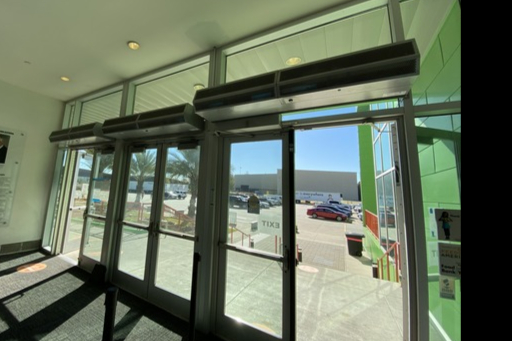Six Ways Air Doors Save Businesses Money
An air door — also known as an air curtain — has a way of solving multiple problems at once for businesses. From enhancing operational performance, increasing comfort and productivity, solving logistical problems to acting as a key building block to true building sustainability, they perform at a high level, provide a multitude of benefits – all with a short ROI.
Here are six of the top ways an air door saves money for businesses:
1. An Air Door Provides Energy Savings
Unless you live in a climate that’s 72ºF at 40% humidity year-round, chances are you need to keep the indoors at a different temperature setting than the outdoors.
An air curtain isolates the interior climatized air from the outdoor heat or cold, humidity, wind and debris. Whether running air conditioning or heating, humidification, or dehumidification, that air you pay to climatize won’t realize infiltration from the exterior which results in energy savings for your business.
Here’s how this benefits your business:
- The heating or cooling system runs less often which extends its lifespan and decreases maintenance.
- You can leave your doors and windows open without losing treated air.
- You spend less on electricity or gas to heat or cool the building.
- Your overall carbon footprint is lower.
If you’re looking to cut costs without sacrificing an open-door environment, an air door is the answer.
2. Your HVACR System will Live Longer
When you leave your doors and windows open to the elements or when customers or personnel constantly open and close doors, letting your treated interior air escape — that means more work for your heating, ventilation, air conditioning, and refrigeration (HVACR) system.
These systems require annual (or more frequent) servicing and involve filters, refrigerant fluids, power systems, and moving parts. The more they run, the more wear and tear they endure.
However, an air door provides the following benefits to your HVACR system:
- The system runs less often.
- Pollution, allergens, and dust aren’t pouring into your business space and clogging filters.
- Compressors have extended lifespans.
That translates to significant cost savings and better indoor air quality.
3. Your Employees Are Significantly More Productive
It may seem counterintuitive at first — how can an air curtain help productivity?
However, there exist several well-documented ways that air doors boost overall worker performance:
- Staff is more comfortable. Pleasant temperatures lead to less distraction, and without exterior air infiltrating the building, temperatures will stay where you want them.
- Customers are more likely to enter. An open-door retail space leads to more customer entry rates, which leads to more sales and more productive employees.
- Workers can move in and out more freely. For dock doors, refrigerated units, walk-in freezers, and the like, an air curtain cuts down on time spent opening and closing doors. Workers can freely move between different climate zones without stopping.
4. Fewer Workplace Accidents
From reducing door-related injuries to eliminating wet and slippery conditions by entranceways (think of large warehouses with lots of foot traffic and forklifts and other equipment moving around), air curtains cut down on workplace accidents. Consequently, this leads to fewer medical claims and less loss of work.
5. Temperature-sensitive Products Won’t Spoil
Temperature stability is necessary for several industries:
- Medical processing
- High-tech manufacturing
- Food industry
Air curtains keep cold areas cold, keep contaminants from entering, and serve as an “air curtain tunnel” to clean debris off entering team members to avoid contamination.
6. An Air Door Doubles as Green Pest Control
Even a traditional door that opens and closes freely can’t match an air door for pest control. Flying pests hovering near the outside of a door get sucked inside when the door opens or can wander in through open doors.
On the other hand, an air door keeps pests from entering by pouring a steady “waterfall” of air downward. That means pests — especially those that would disgust customers or carry pathogens — cannot make their way inside. An air curtain keeps them out without any barrier or chemical product.




